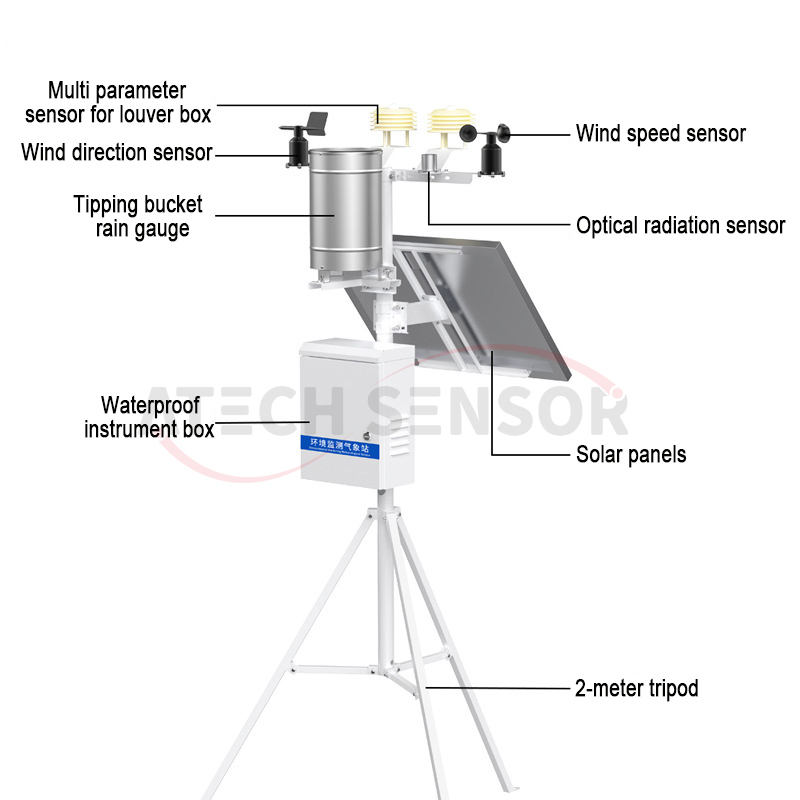In modern agriculture, weather conditions significantly impact crop growth and yield. Agricultural meteorological stations, as an efficient monitoring tool, can collect key environmental data in real time and provide scientific support across various aspects of agricultural production. From planting decisions to field management, and disaster prevention, agricultural meteorological stations are integral throughout the entire agricultural process, helping farmers improve efficiency and reduce risks. This article will explore the specific applications and value of agricultural meteorological stations in agriculture, focusing particularly on the role of field microclimate meteorological stations and field meteorological stations in farm management.

Application Areas of Agricultural Meteorological Stations
Agricultural meteorological stations monitor key meteorological factors such as temperature, humidity, light, and wind speed, offering comprehensive support for agricultural production. The main application areas in agriculture are as follows:
1. Planting Decisions and Crop Selection
Crops require specific climatic conditions for optimal growth, and agricultural meteorological stations help farmers select the best sowing time and suitable crop varieties by monitoring air temperature, soil temperature, and light intensity in real time. For instance, in spring, the monitoring station can determine if the soil temperature reaches the minimum requirement for seed germination, or in areas with insufficient light, shade-tolerant crops can be recommended. These data-driven decisions improve crop survival rates and yields.
2. Field Management Optimization
Field management is a core component of agricultural production. The data provided by agricultural meteorological stations guide activities such as irrigation, fertilization, and weeding:
• Fertilization Planning: Temperature and humidity data help determine the best time for fertilization. For instance, in high temperature and high humidity conditions, the use of chemical fertilizers should be reduced to prevent volatilization loss.
• Weeding and Ventilation: Wind speed and direction data guide the spraying of herbicides to avoid drift, and optimize field ventilation to reduce the risk of diseases.

3. Pest and Disease Control
Many pests and diseases are closely related to meteorological conditions. Agricultural meteorological stations, by monitoring humidity, temperature, and wind speed, assist in predicting peak disease occurrences. For example, high humidity and warm weather may trigger fungal diseases, allowing farmers to spray preventive agents in advance. These preventive measures reduce pesticide usage, protect the environment, and lower costs.
4. Disaster Early Warning and Risk Management
Natural disasters such as droughts, floods, and frosts pose significant threats to agriculture. Agricultural meteorological stations can detect abnormal weather changes early, such as a sudden increase in rainfall or a sharp temperature drop, and issue warning signals. Farmers can then take protective measures, such as reinforcing drainage systems or covering crops, to minimize damage.
5. Agricultural Meteorological Service Support
Field Microclimate Meteorological Stations: Smart Assistants for Precision Agriculture
1. Real-time Environmental Monitoring
2. Irrigation and Drainage Optimization
3. Pest and Disease Prediction and Control
4. Remote Management and Convenience
The portability and high precision of field microclimate meteorological stations make them ideal tools for modern precision agriculture, helping farmers address local climate challenges.
Role of Field Meteorological Stations in Farm Management
1. Precise Irrigation Management
By monitoring soil moisture and precipitation, field meteorological stations help farmers determine the optimal time and amount of irrigation. For example, during dry weather, the data guides increasing irrigation frequency, while in the rainy season, it reduces artificial watering. This fine management ensures balanced crop water levels while conserving resources.
2. Pest and Disease Control Support
3. Crop Growth Optimization
4. Data Support for Agricultural Services
Advantages and Future Potential of Agricultural Meteorological Stations
• Real-time Data: Rapid data updates ensure timely decision-making.
• Accuracy: High-precision sensors provide reliable information, minimizing errors.
• Convenience: Wireless transmission and remote access improve usability.
In the future, as the Internet of Things (IoT) and big data technologies continue to evolve, the functionality of agricultural meteorological stations will expand further. For example, multiple stations can be networked to form regional monitoring networks, and AI analysis can predict crop yield or disaster risks. This intelligent upgrade will propel agriculture towards higher levels of precision and sustainability.

Conclusion

